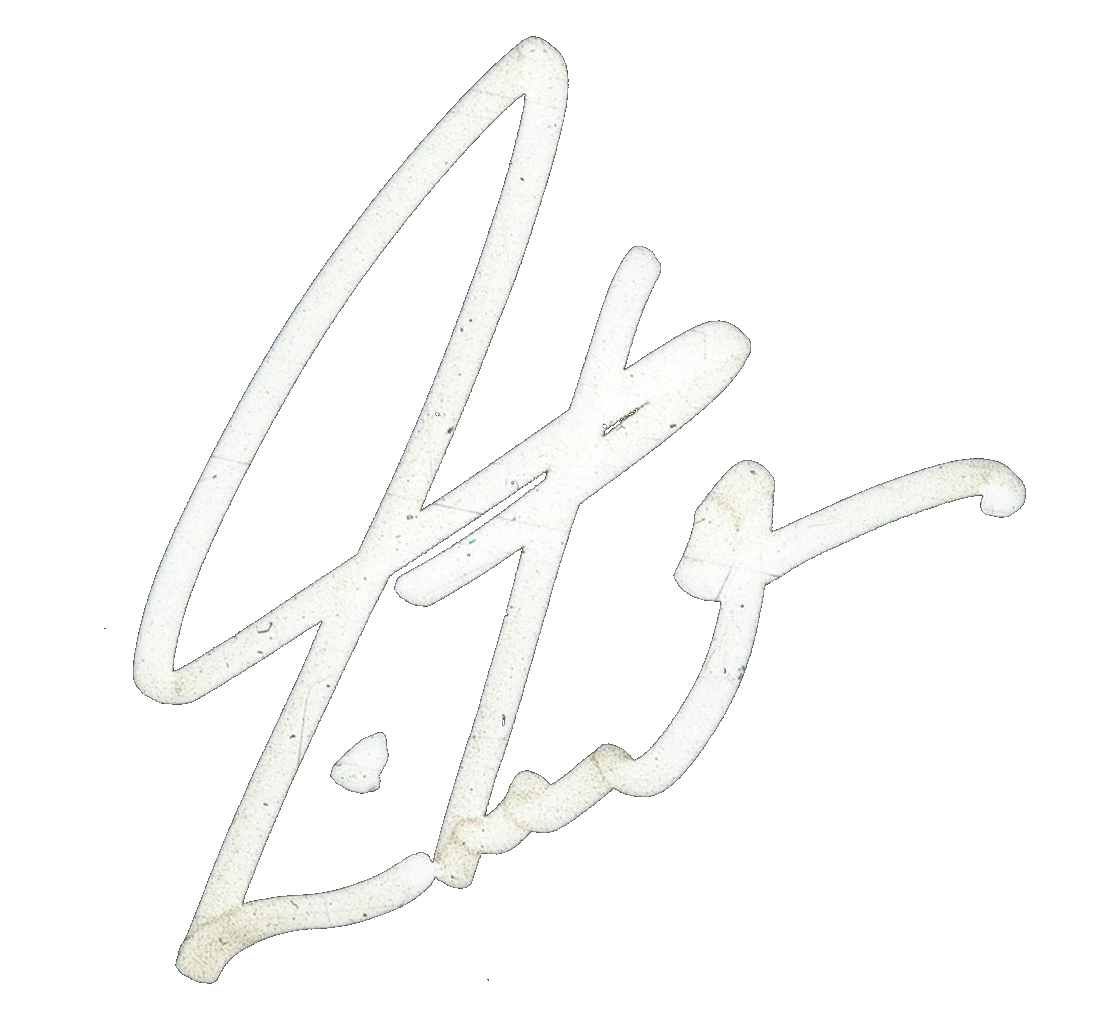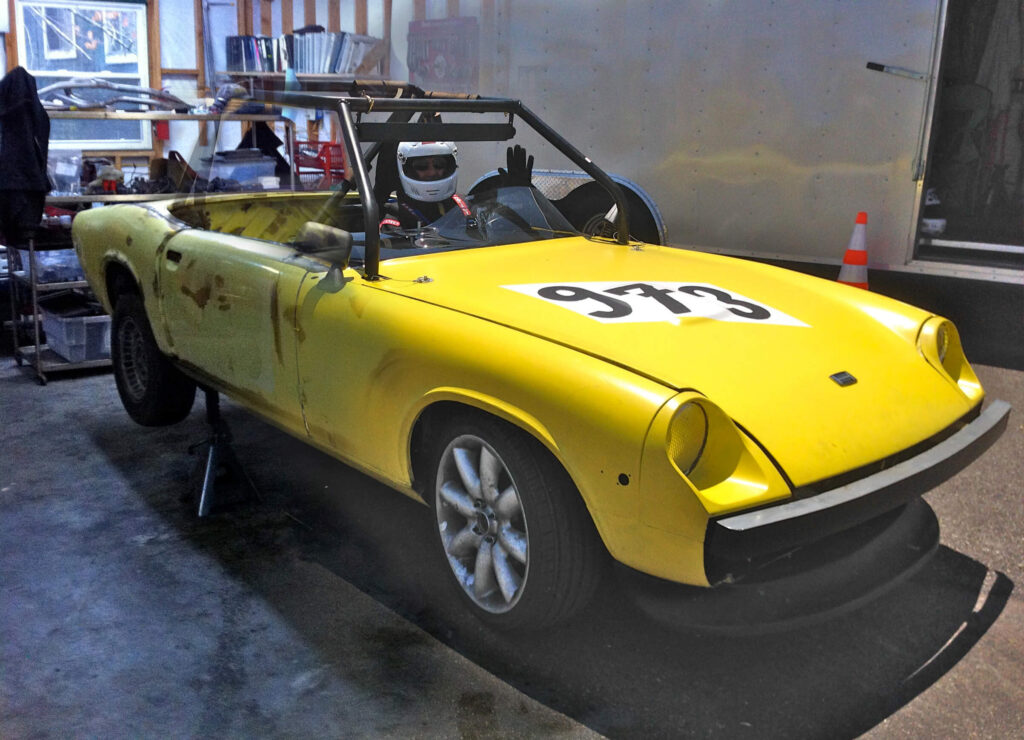
Chapter Three — Bamm Bamm and the Black Flags
Friend and frequent collaborator Greg Russell was once fool enough to pronounce himself “Master of All Things Creative.” Apparently it never occurred to him that he would never hear the end of that. Or maybe it did. What fools these masters be . . .
That job-description includes being the art designer on my website, for which Greg created the above “fade” to announce the posting of “Bamm Bamm and the Lemon Slug.” He began with the car under construction in Clouseau’s shop in February 2014, then worked in Bamm Bamm’s first testing day at Willow Springs in May.
The Utah race was in early June and by July I had the story written, but it was not published until December—immediately after this third race. It had been difficult for me to hold it back for almost six months—being both impatient and eager to share the story—but I had to. As I explained to Clouseau at Thunderhill, “It’s not like there would be dozens of people flocking here to seek me out. It would probably be just one or two—but they’d be really, really weird.”
Shame, of course, but I can only blame myself for not being content just to hit things with sticks, and having taken up lyric-writing. If only I had known. Drummers seldom attract anyone more deluded than other drummers (!), but the power and mystery of words means that mentally-unbalanced souls will come up and stare with laser intensity into my eyes while saying, “That song you wrote . . . is about me.” Or about God, whichever—both kinds of delusions are at least uncomfortable, and at worst dangerous. So best simply avoided.
Speaking of mentally-unbalanced souls . . . looking at the above photograph of our Lemon Slug’s humble, innocent beginnings reminds me of how naïve and optimistic we all were. The Bangers ’n’ Mash team entered our first 24 Hours of LeMons race just a month later, in Utah, in June. And what a drama that had become! But we emerged from it energized and purified, defeated only by mechanical gremlins. Our second attempt, at Thunderhill Raceway in September, was once again beset with evil spirits.
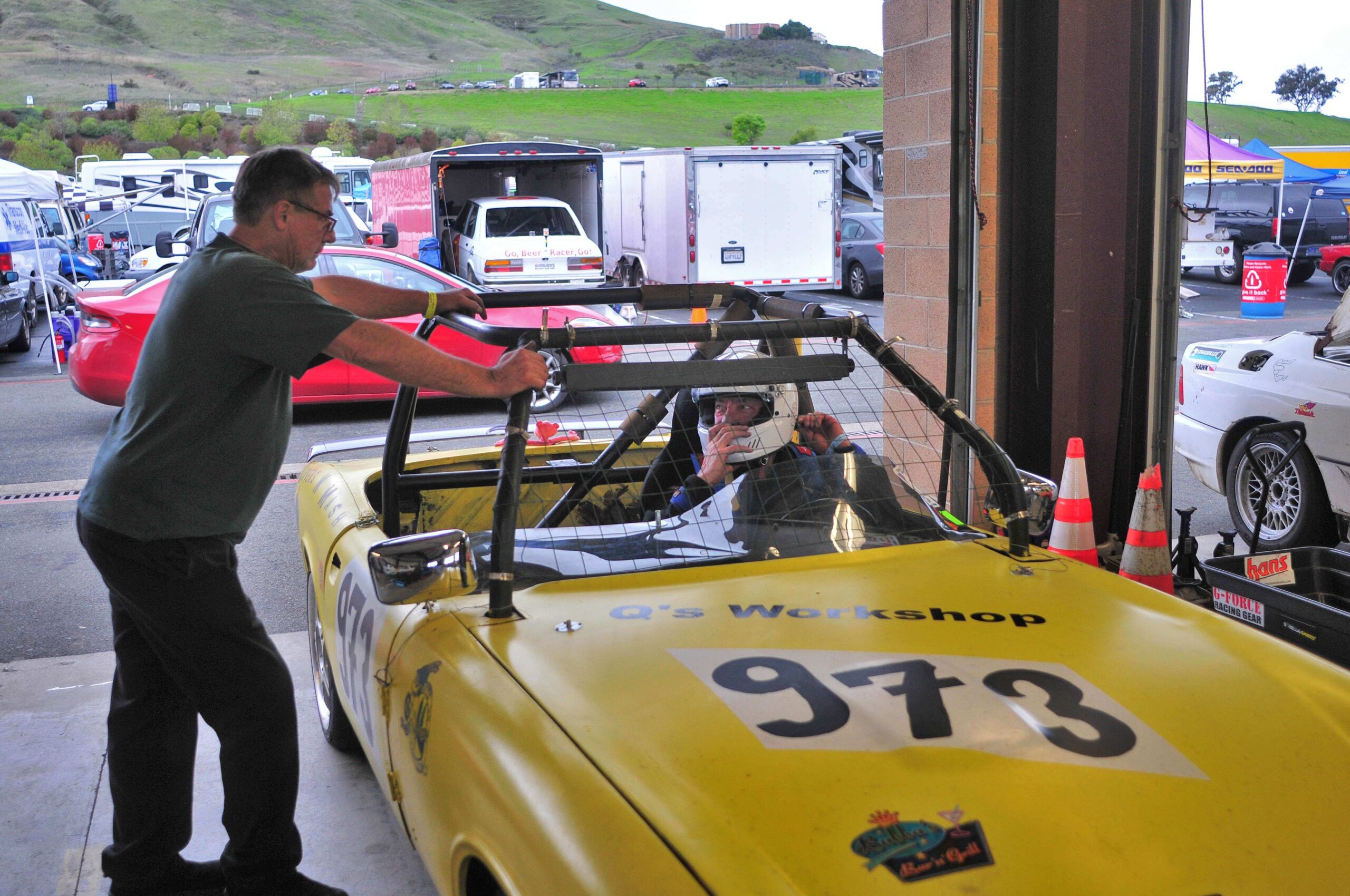
Heading Out For a Test
photo by Craig M. Renwick
Yet our own spirits were undimmed. For the third race’s online entry form, Clouseau chose the codeword “thirdtimesacharm.” Through October and November, he found time, and even a little paid help, to make some good improvements to the car. Now it was December, time for our third and final “quixotic campaign” at Sonoma Raceway.
Craiggie and I arrived the night before, by commuter airline and Aston Martin Vanquish, respectively. We settled into a hotel right on the main square of the town of Sonoma. (Recommended by the Brutus Travel Agency—always the best choices.) In the Spanish colonial era, Sonoma was the northernmost of a chain of twenty-one missions, each a day’s journey apart, that reached from Baja California. These days, amid the picturesque and prosperous wine country of Napa and Sonoma Valleys, the town of Sonoma (population 10,000) is much wealthier and “showier” than, say, Willows. Sonoma is famously pretty, day and night, with lights sparkling in the trees of the eight-acre main plaza, the largest in California. Craiggie and I ate, drank, and slept splendidly, then headed for the racetrack in the morning.
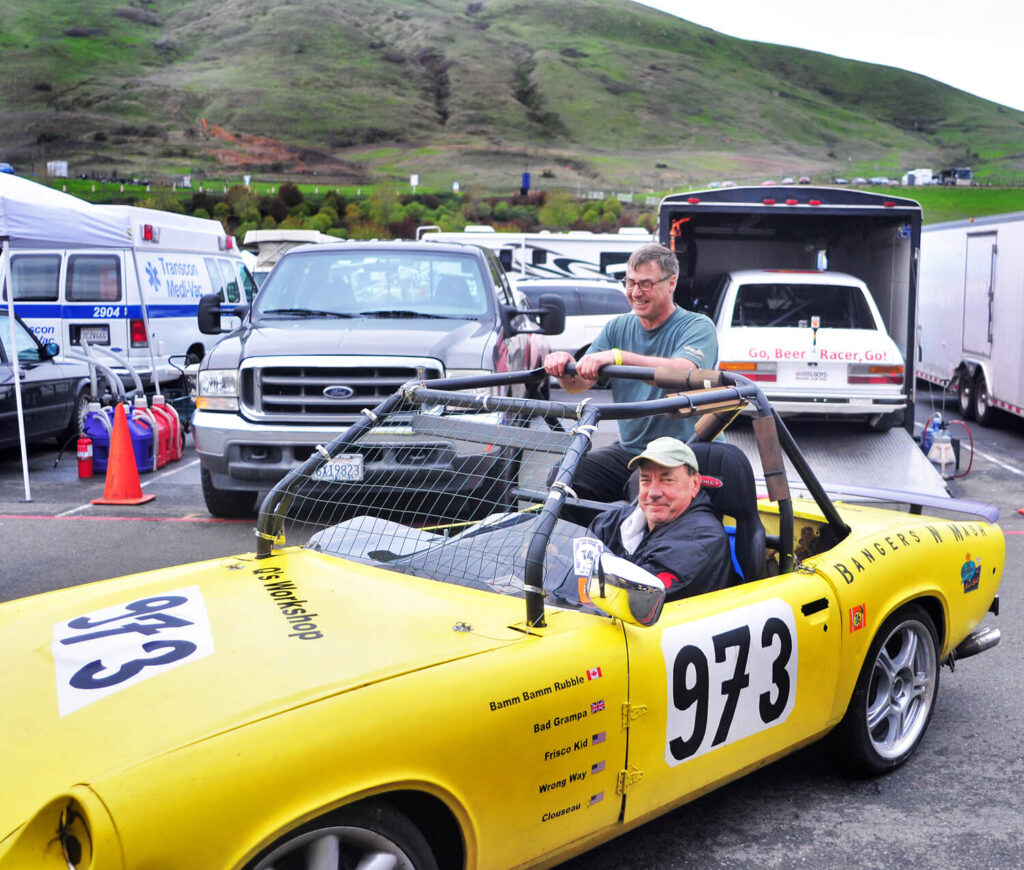
photo by Craig M. Renwick
As Craiggie observed, this image evokes several nice qualities about LeMons racing—the good humor, the camaraderie, the casual way in which the serious business of racing is pursued. As time passes and gives perspective to those experiences, I know I will cherish those memories forever.
Friday was the tech inspection and practice day, and it began cool and rainy. Just looking back on the three racetracks and their weather was a dramatic contrast—warm and arid in the high desert of Utah, parched and baking in the Sacramento Valley, and now damp and cool on the shore of San Pablo Bay. (Stepping into my naturalist boots for a moment, the bay is a tidal estuary, open to San Francisco Bay at one end, and receiving fresh water from the San Joaquin and Sacramento Rivers. The wetlands are a natural treasure for migrating waterfowl, and the area is preserved and improved as a National Wildlife Refuge.)
Bad Grampa, bless him, had won a “lottery” for a garage space, so this time we and the car would be properly sheltered. The rain made that even more welcome. The other Lemon Sluggers would arrive later, and Clouseau and I took our time getting our equipment and tools organized. Bamm Bamm drove the Lemon Slug, with Clouseau perched on the “boot,” down the row of garages to tech inspection. During that day we all had to have our driving suits and helmets checked out, to ensure they met the applicable codes for fire resistance and crashworthiness. (As mentioned earlier, the only thing the LeMons organizers take seriously is safety. The required driving outfits are each worth more than the Lemon Slug!)
By afternoon the rain tapered off, and the track began to dry a little. I took the Slug out for six laps, taking it easy in the uncertain conditions, just to get a feel for the track’s layout. Since taking my first race-car courses at the Jim Russell school in Quebec in the late ’80s, I had only driven maybe a half-dozen American roadrace tracks, and they are all completely unique, by design. The car was running well, and gave no sign of overheating. (The cooler weather would help, of course, and Clouseau had moved the oil cooler away from the radiator.)
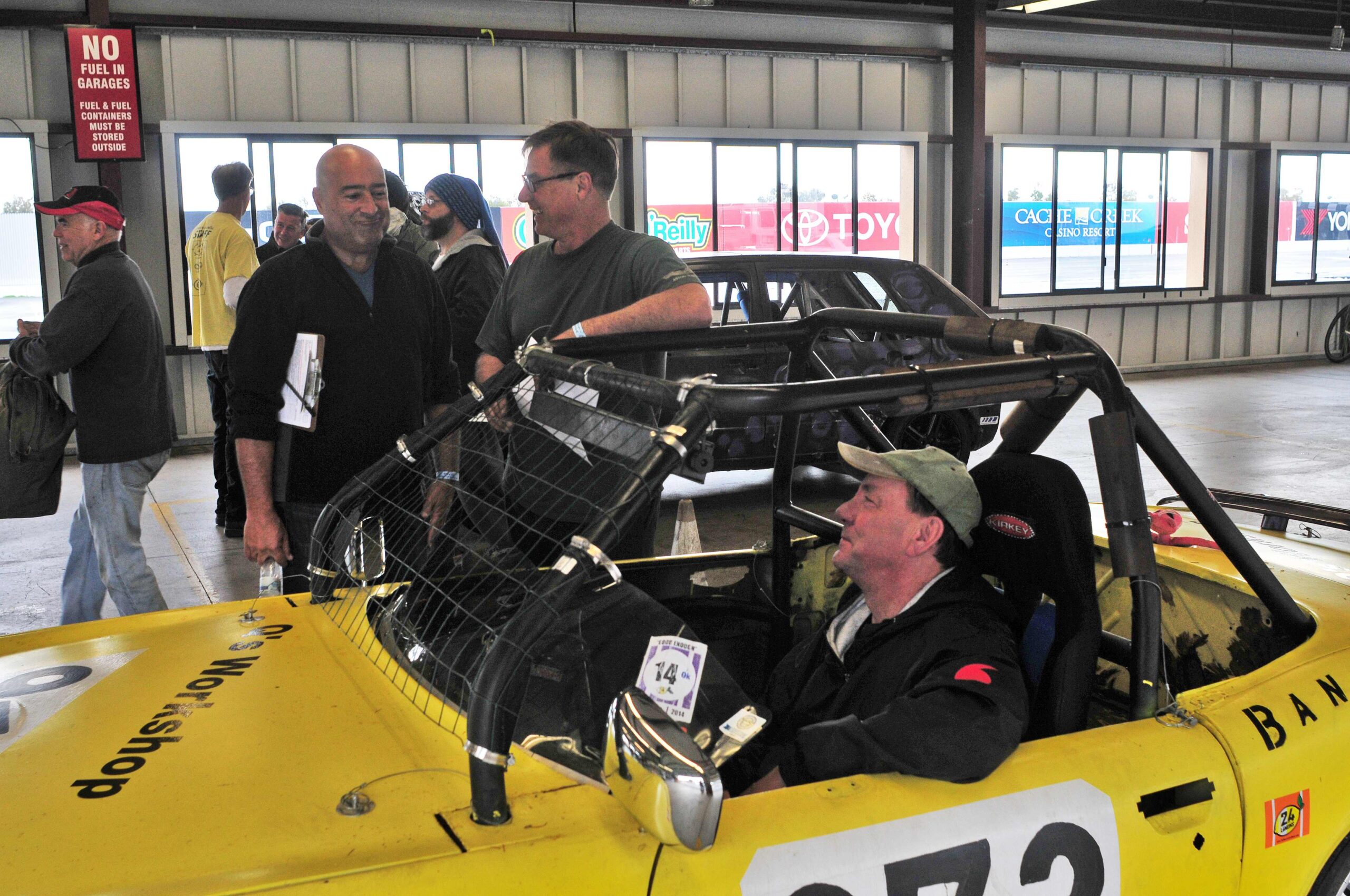
and Bamm Bamm at Tech Inspection
Photo by Craig M. Renwick
Another common factor with each of the three races was that I had never driven any of the tracks before. In the case of Thunderhill, I knew the shorter circuit, but not the new longer layout, so each of those learning experiences had been a study in “processing.” It is worth noting that I have learned how some drivers use different “software” to perform that processing. When I first started attending track days, I would hear other drivers talk about “Turn Six” or “Turn Eleven,” and was puzzled that I could never remember them that way. Ones that had names were easier, but still not the way I thought of them. Some people even learn a racetrack’s layout from films, or video games, but that never “translated” for me either.
It turns out my brain’s lingua franca (perfect—meaning “business language”) isn’t numerical, it is, for lack of a better word, geometrical. More than coincidentally, that is exactly how I describe the way I codify and visualize drumming patterns—not by their numbers, but by their shapes. In a kind of synesthesia, I think of a rhythmic pattern or “decoration,” especially on the fly when I’m improvising, as a kind of pictogram. Or petroglyph—”carved in rock,” exactly.
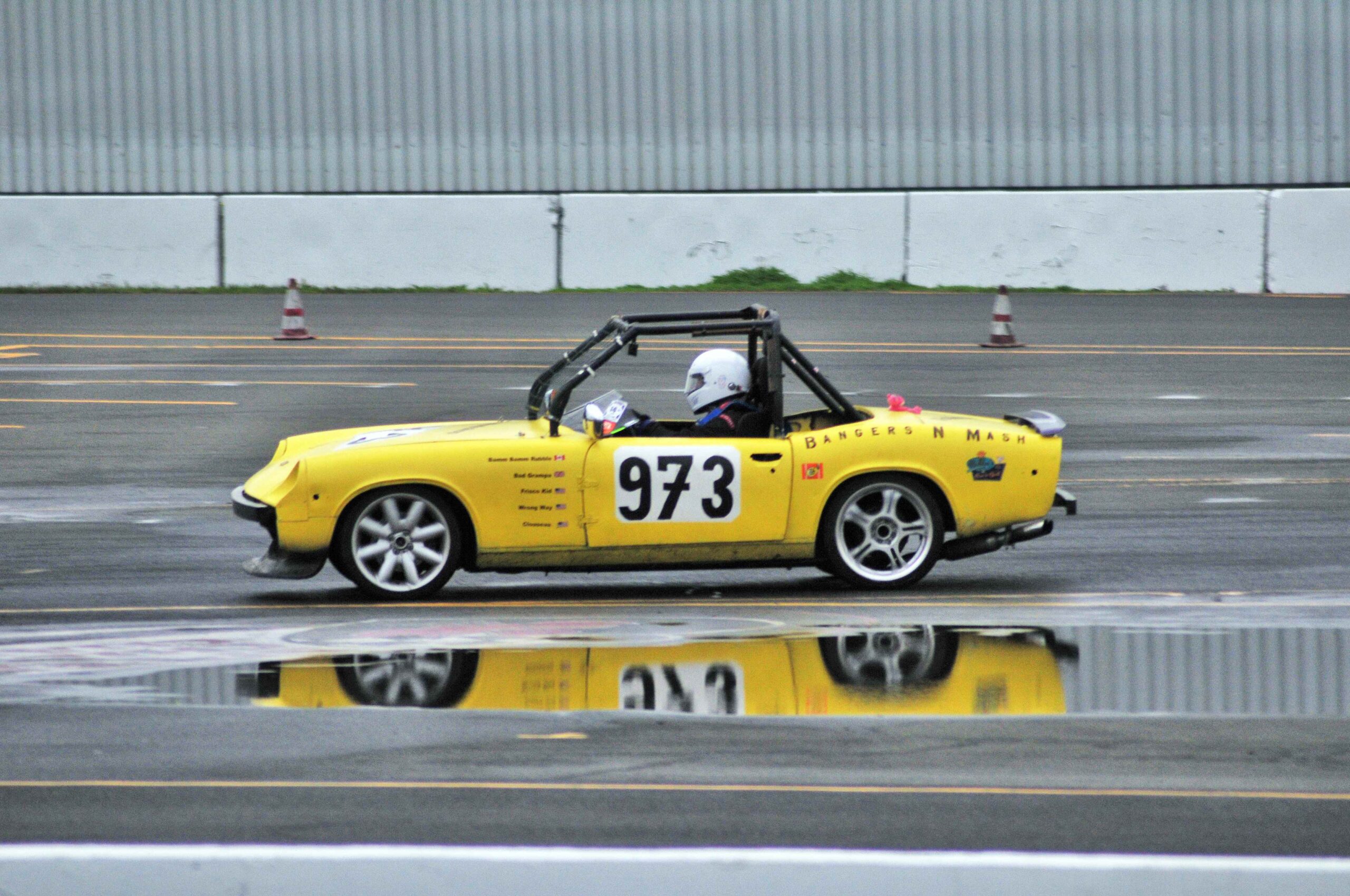
photo by Craig M. Renwick
And more, I learn a racetrack exactly the way I learn a new piece of music. Not by notation, or shorthand notes, or counting bars and measures, I just go at it—flailing my way through. Along the way, one time or the next, I pick up the “milestones” (or braking markers—apt analogy: “Prepare for change”), and try different approaches to each transition. (In drumming I will try everything and throw away whatever doesn’t work—not so much on a racetrack.) Gradually, as my late drumming teacher Freddie Gruber used to say, I “put the pieces together.” Lap after lap, I learn by the shapes, the contours, and the landmarks, until my brain forms a three-dimensional map. Soon I just know that a particular straight section leads to a sweeping left, or a blind hill comes out to a sharp right, or the front straight leads to the fast uphill—stay on the gas.

photo by Craig M. Renwick
(By the way, Craiggie painted those eyeballs for the Sonoma race—gave us a friendly face.)
One particularly fast banked turn around the middle of the track I thought of as the “Carousel.” (Turn Six, to the numerical types.) Discussing that one with my teammates, we agreed it was especially nerve-wracking because it was so fast. If you did overcook it and lose traction, your off-track excursion would happen in a snap. You’d go careening wildly across muddy grass toward a potentially violent sideways stop against a wall of stacked tires. And of course there were other drivers around you in their crapcans, often in over their heads, and as I wrestled through a corner the sound of squealing rubber nearby was always an “uh-oh” moment.
From the exit of the Carousel you could pour it on for a nice long straight, maybe even get into fourth gear!—before braking hard and downshifting to second for a sharp double-apex (two turns in one). Then through a sweet series of esses that could be threaded with a fast rhythm, into a very slow zigzag turn, called a “chicane.” Such obstacles are deliberately placed in the middle of a fast straight to slow everybody down—again, for safety’s sake. The drivers called that chicane the “Bus Stop,” because each car had to slow so much that traffic tended to bunch up and almost come to a halt there. And only one car could sensibly squeeze through at a time—a factor that would come to haunt Bamm Bamm before race’s end. Or at race’s end, for the Bangers ’n’ Mash team.
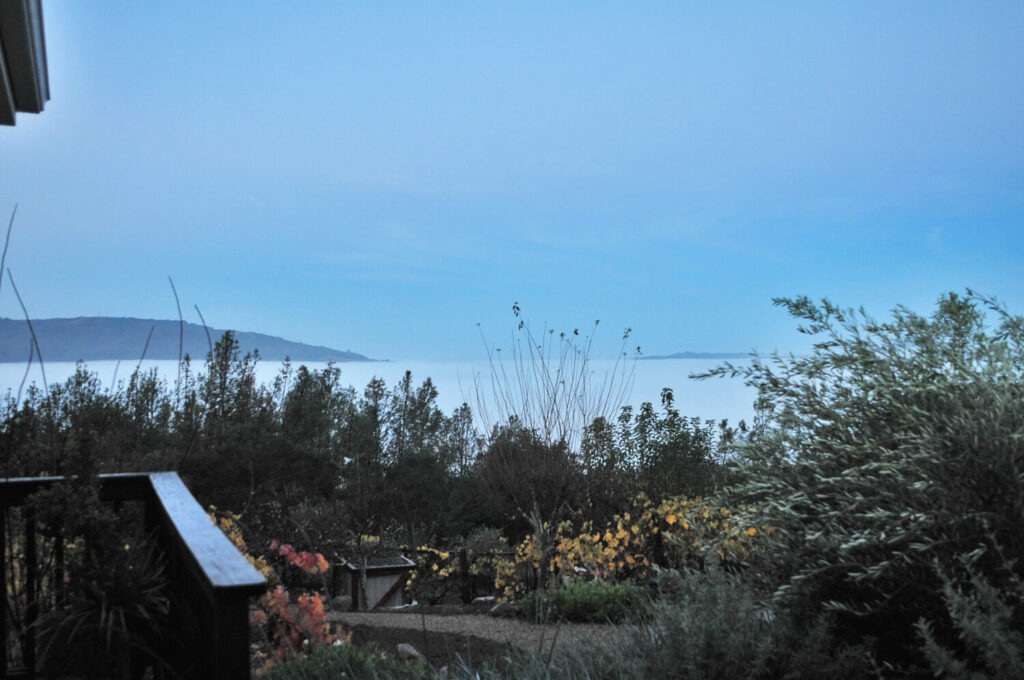
photo by Craig M. Renwick
In addition to providing the garage at the track to house the Lemon Slug, Bad Grampa housed the team—landing us accommodations at a private home in the mountains above the Sonoma Valley. (What a teammate!) Late in the afternoon we all packed up and followed Bad Grampa and Frisco Kid in their Mercedes SUV (the hotted-up AMG version, of course), Craiggie in his rental car, and Clouseau with me in the Vanquish. As we passed through the village of Glen Ellen, I recalled visiting there on my Ghost Rider travels, and hiking in Jack London State Park. Jack London had spent the last years of his life on his Beauty Ranch there, and is buried under a boulder near the ruins of his dream home, Wolf House.
Seems proper to include my favorite Jack London quote:
I would rather be ashes than dust!
I would rather that my spark should burn out in a brilliant blaze than it should be stifled by dry-rot.
I would rather be a superb meteor, every atom of me in magnificent glow, than a sleepy and permanent planet.
The function of man is to live, not to exist.
I shall not waste my days trying to prolong them.
I shall use my time.
Turn by narrow turn, we followed Bad Grampa up a steep and winding road between pines and live-oaks to a mountaintop hideaway. Arriving at a secluded vineyard estate with a spacious home and guesthouse, we admired the view over the Sonoma Valley, Jack London’s “Valley of the Moon.”
Once we were cleaned up and settled in, we carpooled to Glen Ellen, to a restaurant Bad Grampa recommended. We had a fine evening—convivial is the perfect word. From the Latin “live together,” with the emphasis on both words.
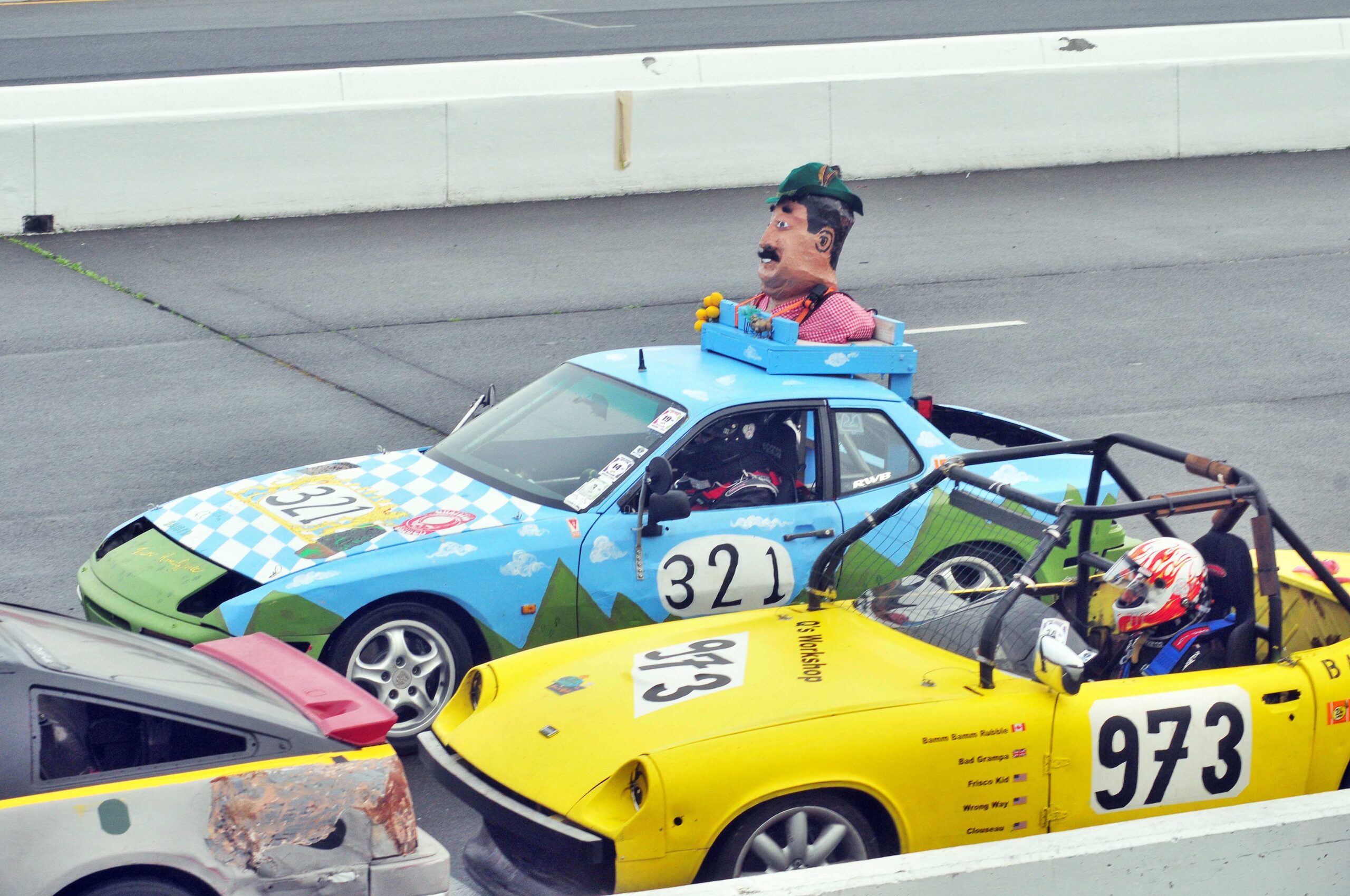
Photo by Craig M. Renwick
Race day was cool, foggy, and threatened rain. The team’s consensus nominated Bad Grampa to start, followed by Frisco Kid, then Wrong Way. Each stayed out an hour or so, and the car was running well. Frisco Kid reported a few intermittent misfires, and had the car die on him once. We watched nervously while a big yellow truck pushed him in, but Clouseau couldn’t find anything wrong. It seemed to run okay again after that, and everybody went around fairly consistently. My turn was next, and I headed out into the fray—with my “game face” on. Things were going all right for a few laps, as I kept the car on the track without anybody crashing into me (though I witnessed a few bangups ahead of me, and around me). The yellow flag came out frequently, usually for broken cars stranded at the side of the track. Everybody slowed down, stopped passing (or being passed), and went around in procession until the emergency vehicles could tow or push the casualty back to the pits. When we got “racing” again, I was slowing for one turn (long straight followed by double apex), and saw a corner worker point down at the Lemon Slug. When I looked in my mirrors I saw a cloud of white smoke.
Oh, that’s never good.
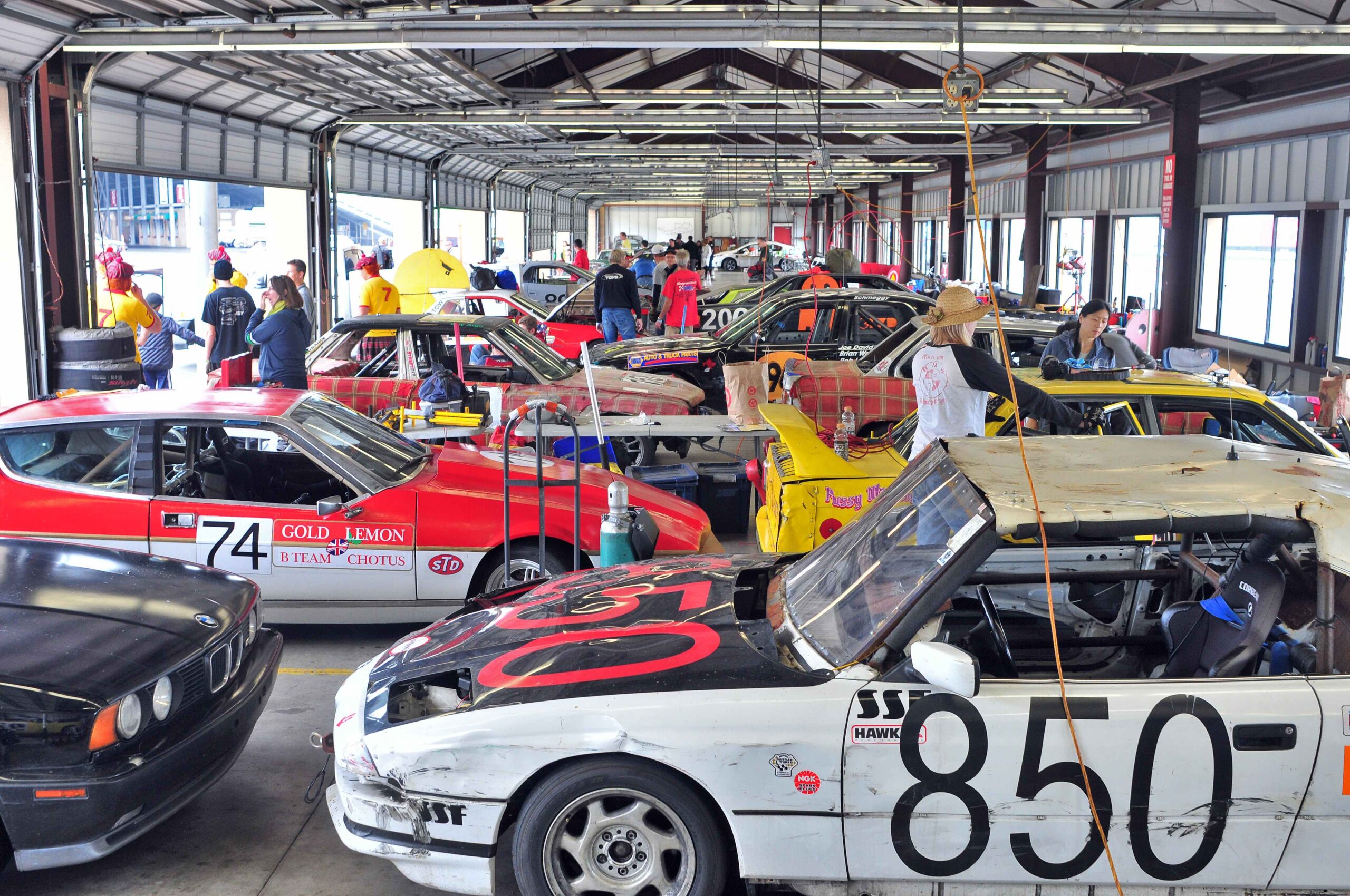
photo by Craig M. Renwick
I headed for the pits, the guys lifted off the bonnet, and Clouseau “inspected.” He soon diagnosed a leaking cam-cover gasket, and I knew that would take a while. I unbuckled all the belts, harnesses, and manacles, climbed out of the car, detached the HANS (head and neck restraint system) device around my neck and pulled off my helmet. I stood by in my racing suit and racing mindset, all tense and “urgent”—it reminded me of when I’m playing a concert and break a bass-drum pedal or snare-drum head. (Not often, thankfully, but two or three times a tour.) Getting through the song as well as I can, I step off the riser so Gump can get in there to repair or replace it, As I stand behind the drums, with the Guys at Work and maybe 10,000 other people waiting—and me in mid-flight—every second seems like an eternity.
Clouseau and Bad Grampa unbolted the alloy cover, and Clouseau decided to replace it with a spare he had. After twenty or thirty minutes they got it remounted to the head with a good gasket seal, and I headed out again. This time I was troubled by intermittent misfires and losses of power, like Frisco Kid had reported earlier. I nursed it around a few times, but eventually it died—right at the pit-exit lane. I coasted to the side and sat there until one of the emergency trucks came up behind me.

photo by Craig M. Renwick
Even that early in the race the crews had been busier than they probably were in an entire “professional” race weekend—because by definition, these cars are lemons, and they break down a lot. I suspect the rescue crews were growing a little impatient—because when they came up behind me they just started “bumping” me back to the pits, jolt by jolt.
Again I stood in the garage in racing gear and anxious showtime mindset while Inspector Clouseau probed, tested, and “inspected” all around.
The toggle switch that served as our on-off ignition was loose, and he tightened it. That seemed to be it. Out I went again, and as I came around the hairpin onto the front straight, passing the garages, I gave the team a quick thumbs-up, then completed another few laps before bringing it in.
With those tense delays, plus the even more anxious time in the “thick scrum of crapcans,” it seemed to me my shift had been about three hours. (All told it was less than two.)
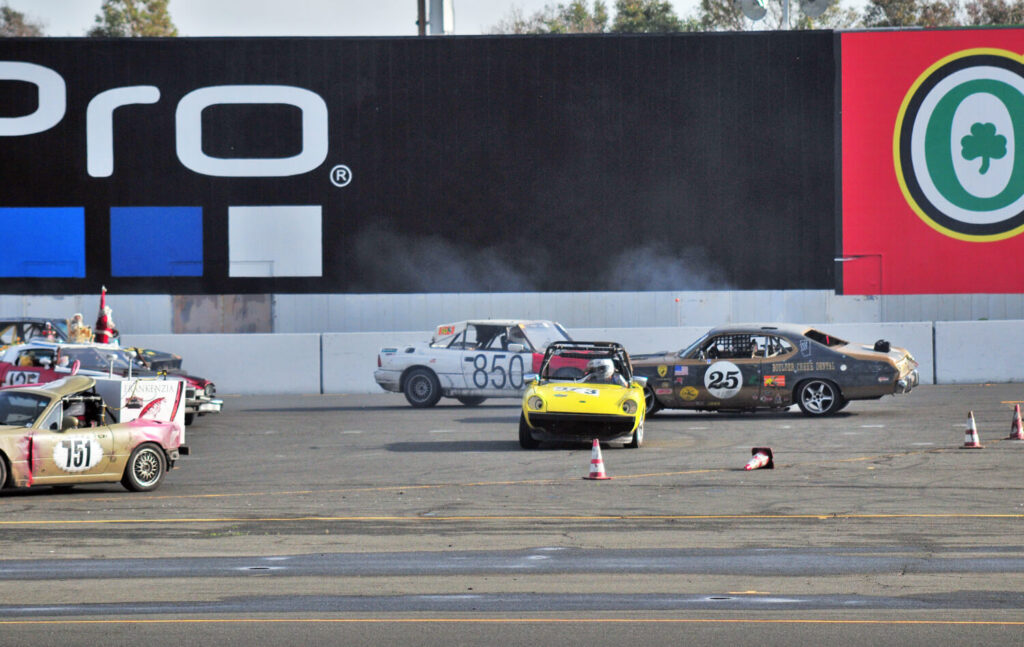
Photo by Craig M. Renwick
The phrase “thick scrum of crapcans” echoed in my mind many times when I was on the track in the Lemon Slug, fighting for survival among all the other Lemonsters. It came from founder Jay Lamm’s description of the 24 Hours of LeMons experience. “Yeah, it’s real racing. That said, between the thick scrum of crapcans in front of you and our aversion to long, flat-out straightaways, you’re not going to set any speed records.”
Apart from the number of cars I drove past that had expired trackside, others had spun off into the muddy grass, or into each other. The “meeting” pictured above took place behind me, car number 850 bashing into 25 and spinning him around, and I wasn’t even aware of it. Other times I was keenly aware—like when one car took out another like that ahead of me, in a mid-turn T-bone, leaving me nowhere to go and no traction to get there.
So I was relieved to bring in the car undamaged, and Clouseau went out next. After twenty laps or so he came in shaking his head, saying the engine was only running on three-and-a-half cylinders. An hour or so later, Bad Grampa reported the same. Watching from the garage window, we could see the evidence on every lap, his reduced speed and power when he got on the gas coming out of 11a to the front straight. (Some of the guys were watching everybody’s lap times transmitted on a cellphone app, but I decided not to ask. I might be the slowest by a few seconds, fine—but it wasn’t hurting our chances so far, and I didn’t need to know that potentially humbling data.)
At the end of the day, Clouseau did some more tweaking, and learned that the second carburetor hadn’t been opening fully, and decided to change to different sparkplugs.
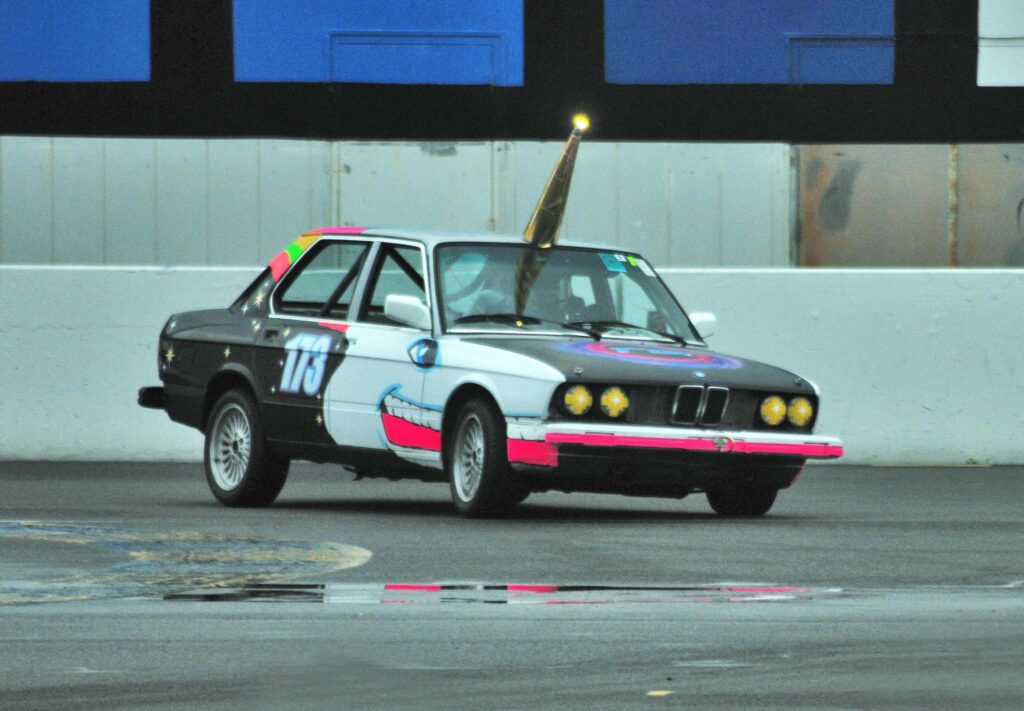
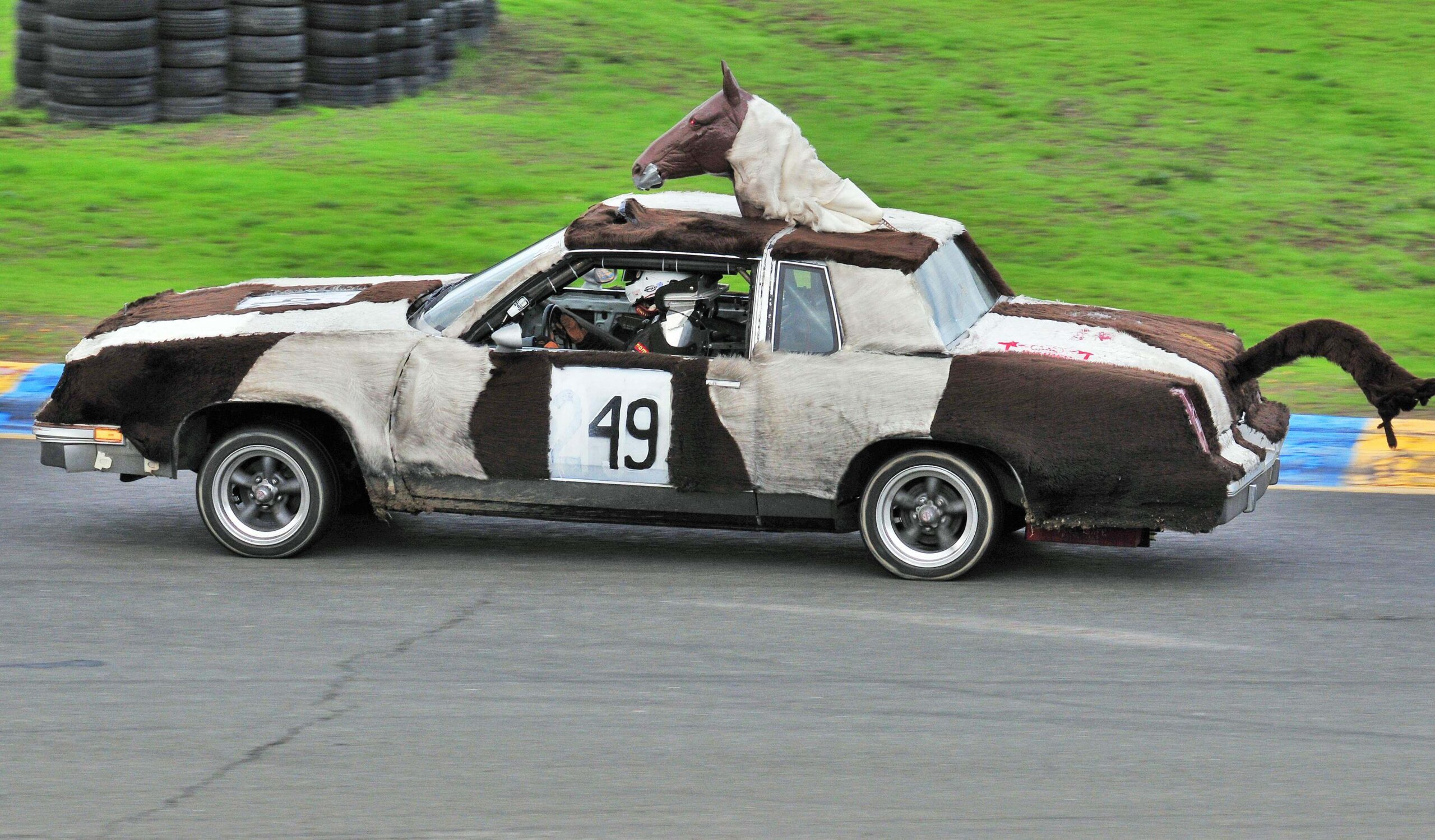

More Deadly Serious Competitors
Photos by Craig M. Renwick
As we watched Bad Grampa chasing the unicorn BMW for a few laps, I said it was like a scary fairy tale: “Bad Grampa is chasing the unicorn!” When Bad Grampa eventually came around ahead of the unicorn, I narrated with shock and horror, “Bad Grampa has killed the unicorn!”
One other competitor at the Sonoma race deserves special mention—another Jensen-Healey! The year-end wrapup of the 24 Hours of LeMons series appeared on Car and Driver magazine’s website, in an article titled “The Most Amazing LeMons Cars of the Year.” The organizers singled out our car—the Lemon Slug! They reported that in the eight years the series had run, ours was the first entry of a Jensen-Healey—and that at the Sonoma race, there’d been a second. That car and its team put us to shame with their costumes and props—they were one of the outright stars of LeMons. Playing on the Austin Powers movie Goldmember, they went to town with it, right down to the golden phallic guns—and the characters, from Dr. Evil to Foxxy Cleopatra . . .
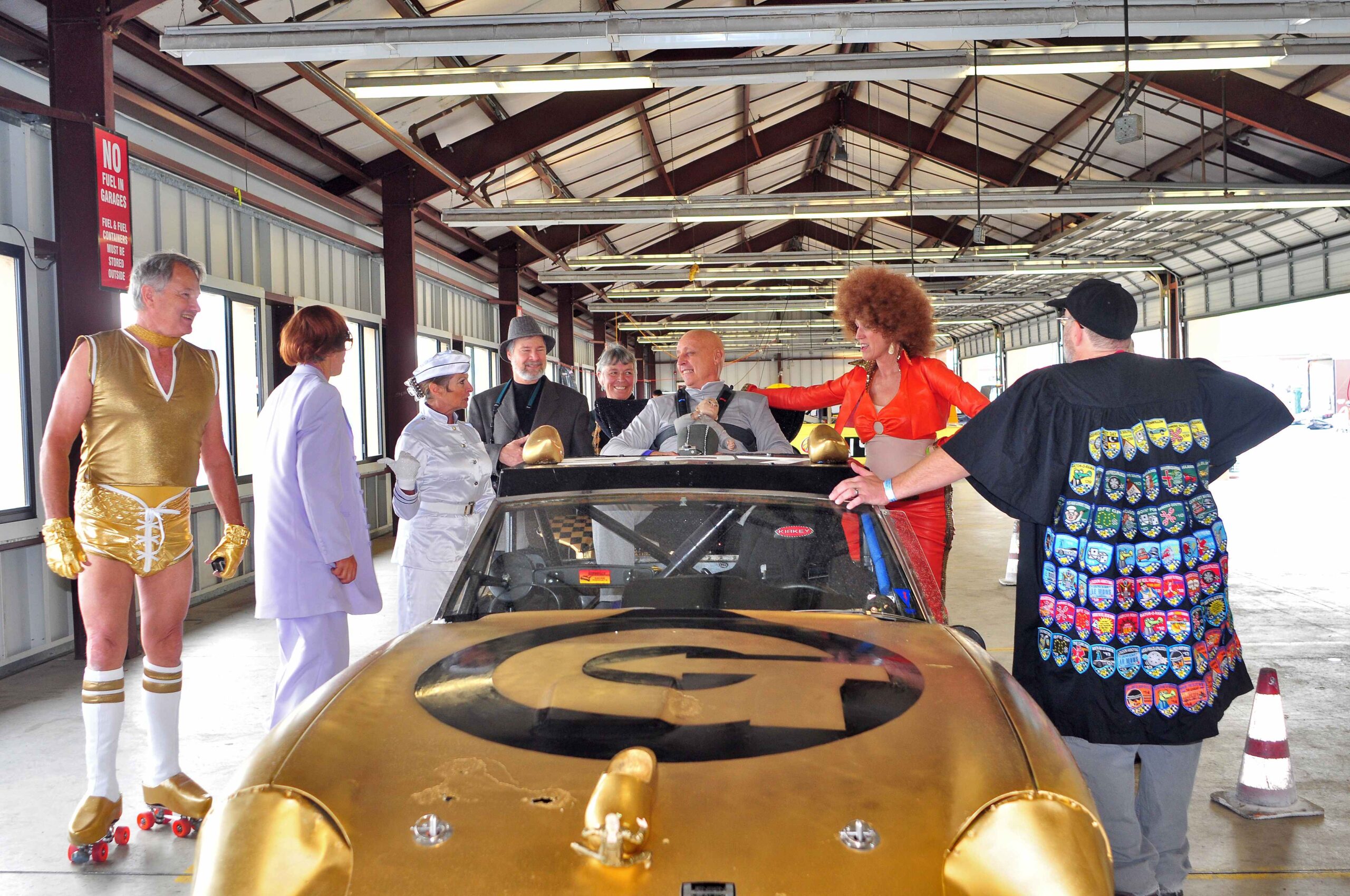
Photo by Craig M. Renwick
(Their race number, 907, is a subtle reference to the engine we shared: the Lotus 907 that had figured so large in our “Miracle of the Gulls” award in Utah. The “miracle” being that we found a replacement for our blown engine under a workbench in a garage at the racetrack. Our number is from the model year, 1973.)
The day’s tasks done, Craiggie drove Bamm Bamm and Wrong Way in his rental car to a grocery store in Glen Ellen. I had volunteered to cook dinner for the team that night, and was thinking of one of Chef Bubba’s mainstays that would require minimum preparation and adapt to any number—maybe a shrimp or chicken pesto pasta. The market’s selection of everything from fresh produce to cheeses was very good, as Bad Grampa had assured me. The shrimp were on the small side—”shrimpier” than I like for sautéing in butter and garlic—so I opted for chicken instead. I would cut it into triangular bite-size pieces and fry them in olive oil before mixing in some artichokes to heat, and finally the pesto and pasta. (Topped with freshly grated Pecorino, naturally.) Craiggie picked out the ingredients for a Caesar salad, and further armed with a pair of fresh baguettes, we headed back to the house to start preparing.
When the other guys arrived and saw me busy in the kitchen, Frisco Kid asked what I was making. With a lilting Latin accent, I sang out, “pollo pesto pasta!” He smiled, “Oh good—I was hoping for something other than shrimp.”
Right behind him, Wrong Way asked the same question, and after receiving the same operatic reply, he said, “Oh, too bad—I was looking forward to eating some shrimp.”
Later, noticing a pile of artichokes on the side of Craiggie’s plate, I said, “I guess you don’t like artichokes?”
He shook his head and mumbled, “Not really.” Then, being Craiggie, he looked up and smiled, “It was really good, though,” and the others chimed in their agreement.
Cooking for groups larger than one’s family is always a challenge—you can never please everybody (except maybe at Thanksgiving or Christmas). But, as Chef Bubba likes to pronounce after such an event, “Nobody went to bed hungry, and nobody went to the E.R.”
It was another fine evening of conviviality, with plenty of petrolhead talk and typical all-guy raillery and laughter. Once again Bad Grampa contributed generous amounts of the fine local wine. As Craiggie and I walked up the driveway to the guesthouse, a radiant full moon glowed down on a blanket of cloud over the valley below, the Valley of the Moon.

Photo by Craig M. Renwick
Back at the track on Sunday morning, Bad Grampa remarked to Clouseau that he wasn’t feeling his best. Clouseau, a non-drinker, laughed and quoted Frank Sinatra’s famous and profound observation: “I feel sorry for a man who doesn’t drink. When he wakes up in the morning, that’s the best he’s going to feel all day.”
Frisco Kid took the opening shift, with Wrong Way next, then Bamm Bamm. The car was running really well, and for perhaps the first time in our three races it was like we were actually competing. We could keep pace with some of the mid-pack cars, sometimes dicing for position and passing opportunities, and everybody began to relax and enjoy themselves—everybody except whoever was driving, of course; nothing relaxing about that! Between shifts we dared to wander away from the pits to watch the race from the grandstand, or from other vantage points. We stood and enjoyed the novelty of watching the Lemon Slug simply keep coming around every time.
Once when I was on track, a guy came up to Clouseau in our garage and said, “That guy on your team . . . is he . . . the drummer from Rush?”
Clouseau pretended to be puzzled, then said, “What? Who? You mean Brian Griffin?”
His quick-wittedness put a stop to that line of inquiry, and it was the only time I was recognized in all three races—wonderful! LeMons founder Jay Lamm knew from the beginning, because he was a customer of Clouseau’s—in fact, Jay had inspired his interest in LeMons by looking at Clouseau’s “collection” of moribund Jensen-Healeys and suggesting he enter one. Clouseau had told Jay I wanted to remain anonymous, and Jay had kept it close. Apart from my racing alias of Bamm Bamm Rubble, on any LeMons documents I appeared on the team roster as Brian Griffin (the martini-swilling dog on “Family Guy”).
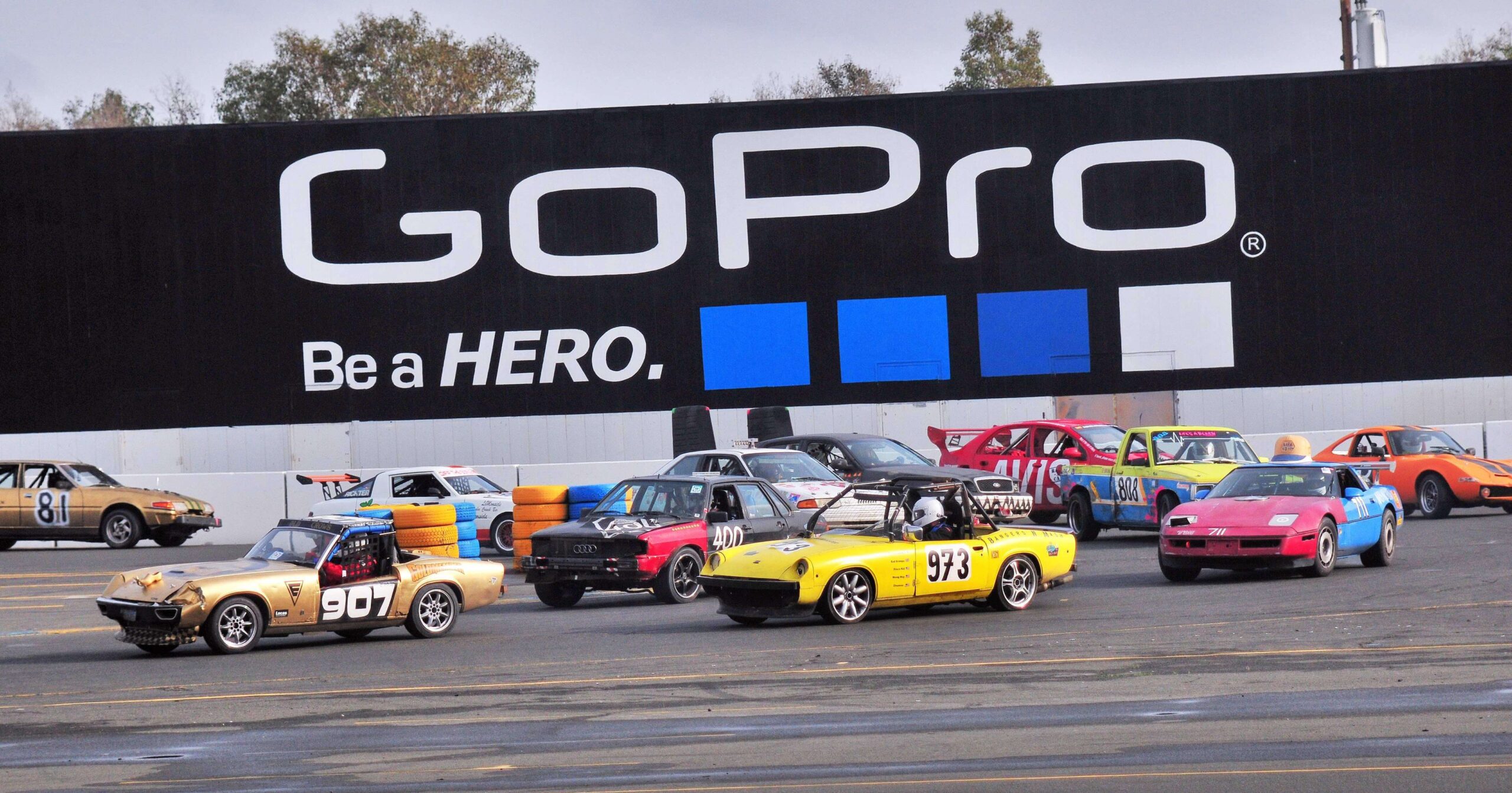
Photo by Craig M. Renwick
In the above photo I am chasing the Goldmember Jensen-Healey, 907, and to our team’s amusement and pride, I passed it. Once. (Alas, 907 would do better than 973 in the final standings.)
On Wrong Way’s shift he had bashed into the back of another car, when he was caught “with nowhere to go”—hitting hard enough to bend the quarter-inch angle iron that served as our bumpers. That was one black flag offence, and he garnered another for an off-track excursion. Clouseau had a couple, and so did Bad Grampa and Frisco Kid. (Bamm Bamm had been spared any black flag infractions, only because he was the slowest driver, and thus remained farther from the “edge,” so to speak.)
One incident of Frisco Kid’s demands to be shared. For context, the reader should know that there were a handful of female drivers in the race at Sonoma, and that compared to the rest of us grizzled veterans, Frisco Kid is a mere lad of twenty-nine.
When I asked him to give me the details, I realized it was best described in his own words:
Ha! Well because we have such good brakes on the car, the guy in front hit his brakes far sooner than I would have—good thing we have square steel bumpers.
When I pulled into the pits, the ref asked me what happened and I said something like, “Umm, I saw the girl driver, and I saw boobs, and I panicked!” It was a made-up combination of there being one girl driver on track and one car with balloons with nipples on them that was close to me. I have no idea where the story came from, but it seemed like he was talking to me like more of a “kid” so I figured I would disarm him with a good prepubescent answer, to try to make him laugh.
He didn’t even crack a smile—he just said, like a scout leader: “Listen up, kid—half the world has boobies, so you better start getting used to that. Now get back out there.” I seriously doubt he thought I was older than about seventeen at that point.
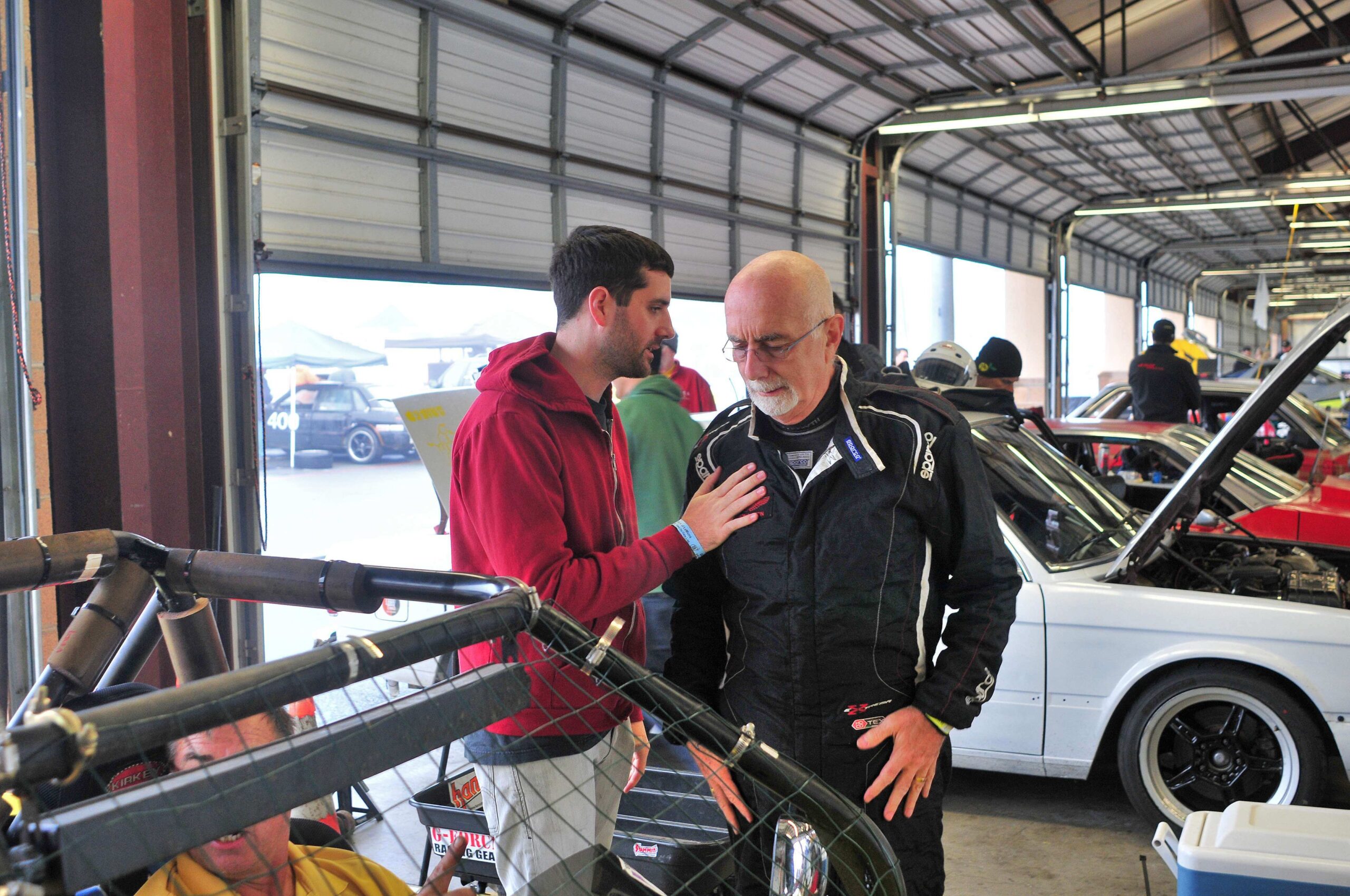
Photo by Craig M. Renwick
We didn’t realize it then, but those black flag offences were piling up.
See, the LeMons judges instruct the corner workers to report anyone who passes another car under a yellow flag, goes off the track, or makes contact with another car. If you don’t come into the “penalty box” garage on your own, the flagger at the start-finish line will hold up a black flag with the car’s number on it. (Over the years of Thunderhill trackdays I had come to know that crusty, good-humored official, Turbo, and he told me later that at LeMons races all he did all day was put up black flags and car numbers.) In Jay Lamm’s speech at each drivers’ meeting, he stressed that they really prefer drivers to come in voluntarily, be “self-reporting,” and would be more lenient with possible punishments.
Such penalties range from a brief delay and lecture to being sent on a complicated scavenger hunt, or humiliations like one driver we saw being paraded around the paddock several times while strapped to the roof of the team’s car with cling wrap.
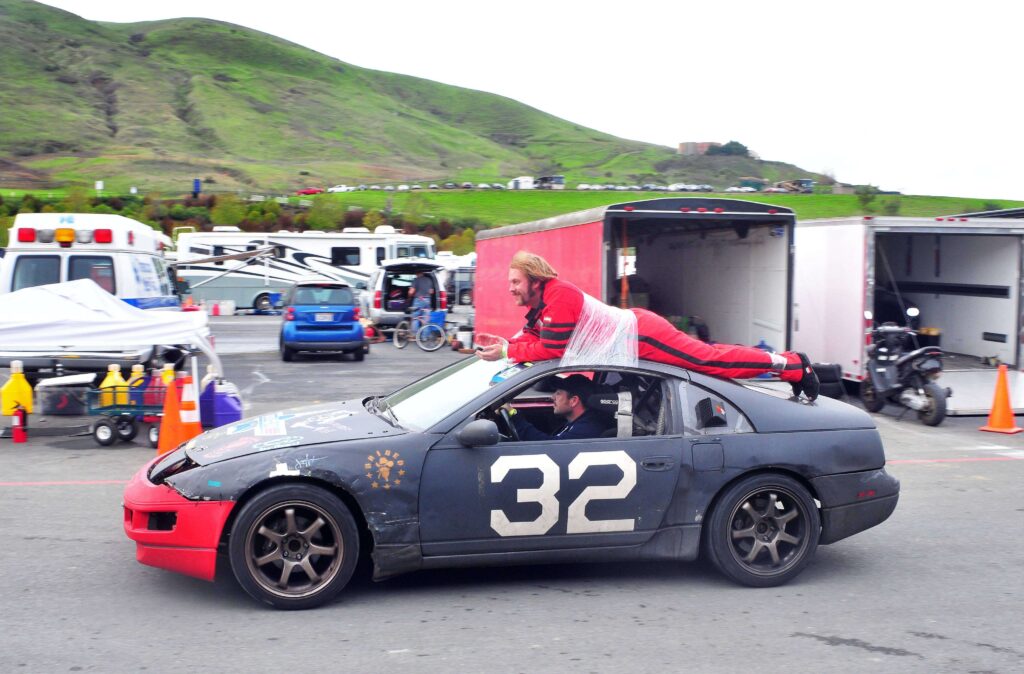
Alternatively, at the pleasure of the judges, you were invited to make atonement with a donation to a children’s charity. Our team did resort to that worthy “bribery”—not once, but twice.
In mid-afternoon of the second day, Bad Grampa was sent off the track for a one-hour punishment—plus a warning that if our team received one more black flag, we would be disqualified, out of the race. Founder Jay explained to Clouseau that they had cracked down on those infractions because they were having too many serious accidents—averaging two “rollover” crashes per race. After tightening the rules, they were down to about two such scares a season—and in 2014 they ran twenty races at various racetracks across the United States.
Given Bamm Bamm’s accidentally untarnished record (so to speak), the team felt that he should be sent out to try to finish. Each of our shifts had typically lasted forty-five minutes to an hour, and there were two more hours of racing time—plus Bamm Bamm was already a little spent from a previous angst-ridden session that day.
But of course he said he would try.
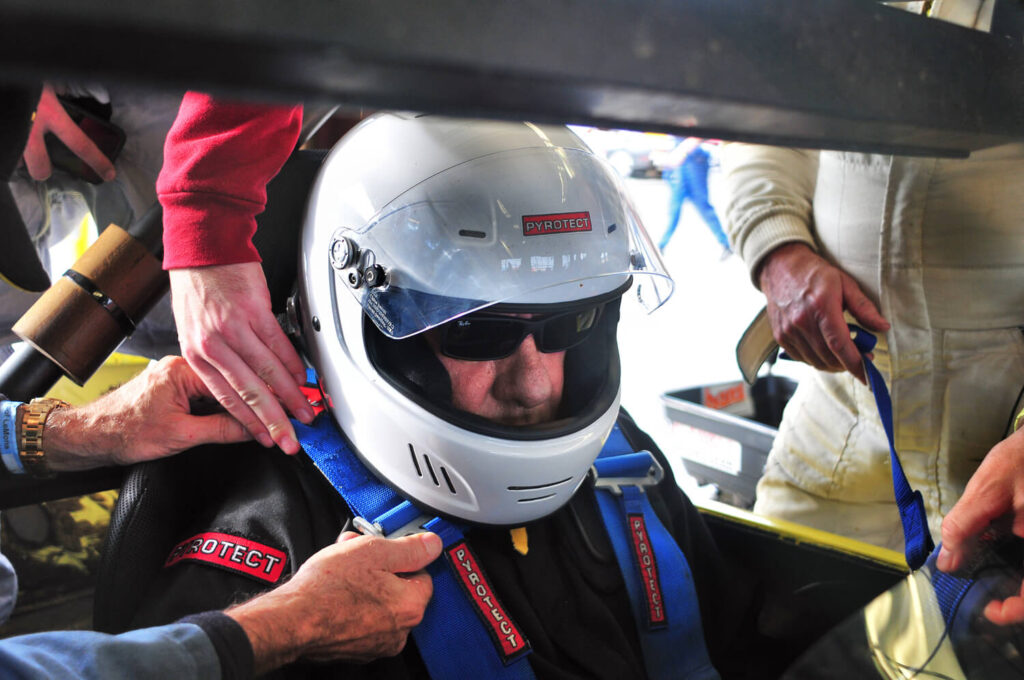
Photo by Craig M. Renwick
The reader may imagine that I felt a certain amount of pressure . . .
For a full hour I was looking good, staying out of trouble and keeping up a consistent pace. The double yellow came out for a long interval (couple of crashed-up crapcans they had to clear away), slowing everyone to “parade speed.” For ten laps or so I could breathe easily, safe from the T-men and so many other things that could go wrong.
I began to visualize the glory of being “the hero,” of driving a flawless two hours and taking the checkered flag for the long-suffering Bangers ’n’ Mash team. The tortoise had a chance to be the champion. When your boyhood fate was to be pathetic at sports, you had no hope of being the one to catch the winning pass, hit the grand slam, or (best of all for a Canadian boy) score the overtime goal. For boys, sports is pretty much the only path to heroism. The default for some of us is setting out instead, all unconsciously, to be our own heroes. That is a different motivation from aiming to be “everybody’s hero,” in athletics or entertainment, and that’s fine—but I was starting to imagine how wonderful it would feel to bring the Lemon Slug across that finish line.
How happy my teammates would be, and how good I would feel.
And oh, how I wish I was sitting here writing that story now.
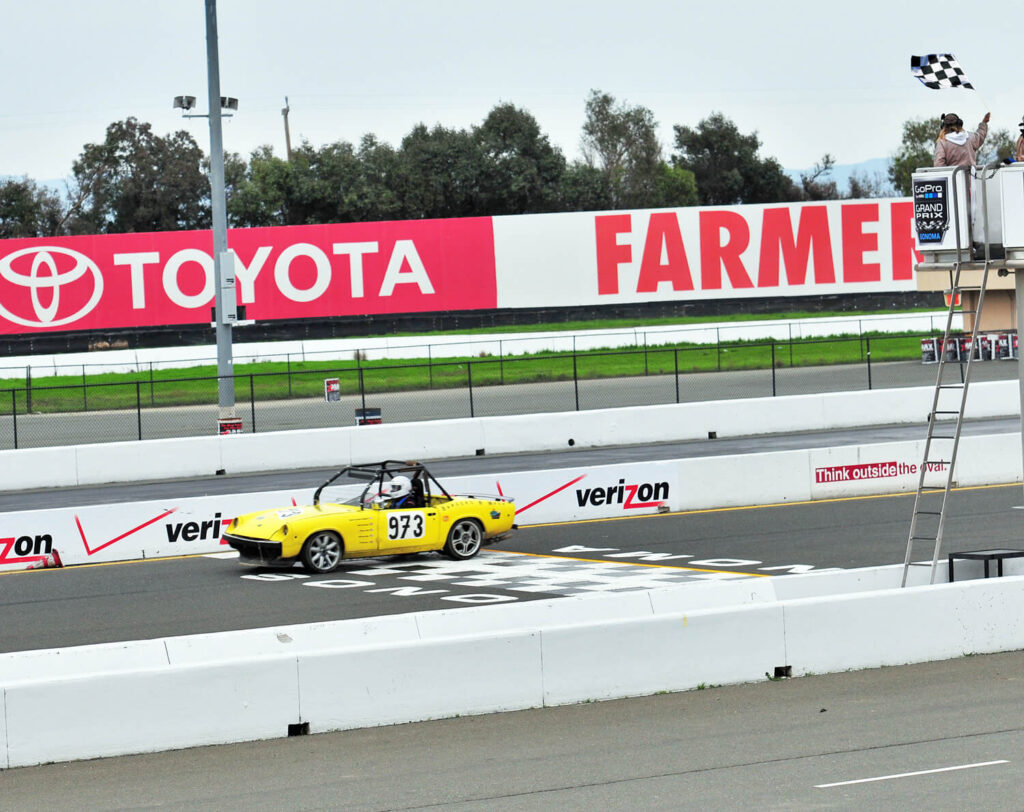
Photo artifice by Craig M. Renwick
But alas, in an ironic twist, this time the Lemon Slug would finish the race, but the drivers would not. With just one hour to go, as I slowed to creep through the Bus Stop, some Mazda or Toyota crapcan nosed in beside me. I was forced to steer wide, to where the pavement was muddy from others’ off-track excursions. My rear wheels slid out, and the car went slewing off the track. Only about ten feet off the track, at about ten miles an hour—but I knew. It was over. Bamm Bamm’s heroic dream shattered around me almost audibly, crumbling from fragments of glory to a sad puddle of . . . reality.
I tried to move the car and drive back to the pits to face my disgrace, but the rear tires spun helplessly on the wet grass. After a few minutes a couple of track workers came up and grabbed hold of the rollbar to give me a push. Back on pavement, I crept slowly around to the pitlane, deflated and disgusted.
Pulling into the garage, I shut down the engine and told the team what had happened. I reached down to turn the lever that would unfasten my belts, harnesses, and manacles, and started to climb out. Clouseau asked if I had reported to the penalty box, and when I shook my head he said, “Go down there—maybe they’ll give us a break.”
So I restarted the Slug and drove slowly down the paddock and into the garage. A female judge came up and pointed to my loosened belts. She laughed and said, “You’re not even belted in—your team must be really mad at you!”
In an Eeyore voice, I replied, “Well, I figured we were done.”
Her voice was kind when she said, “I’m afraid you are, I’m sorry. You’re a nice bunch of guys, but . . .”
I held up a finger and bleated out a pathetic plea, “It was my first one!”
But she just smiled and walked away.
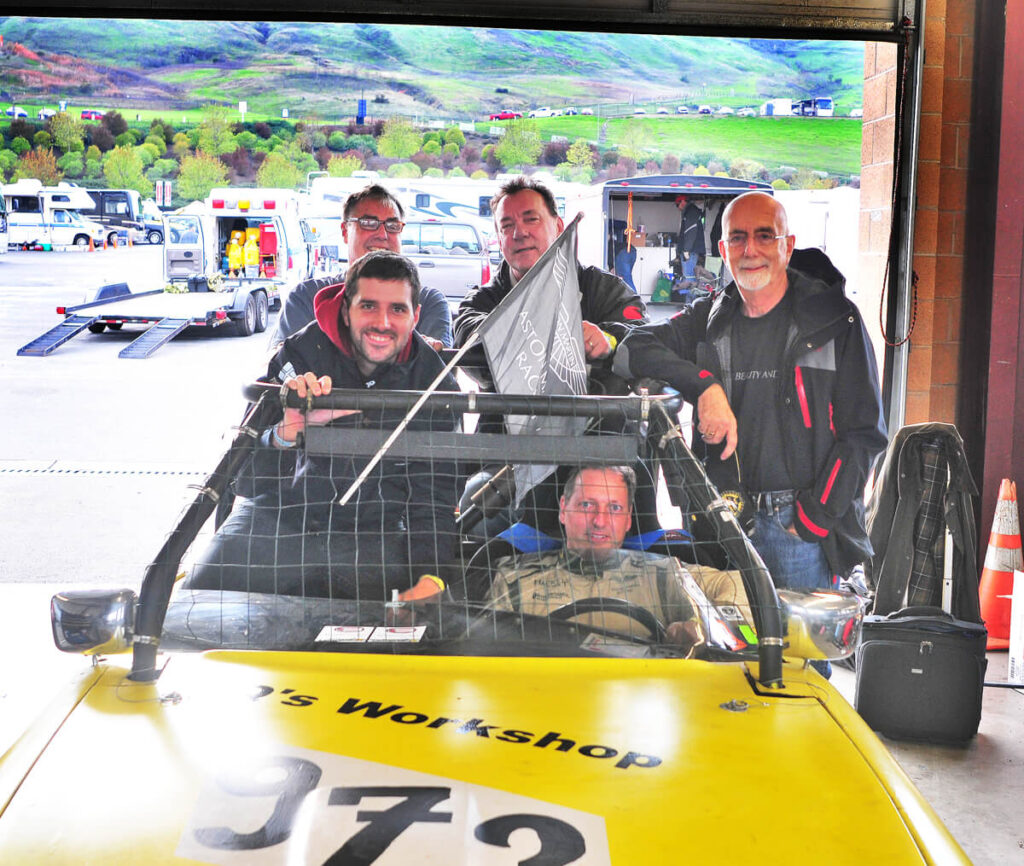
Frisco Kid, Wrong Way
Photo by Craig M. Renwick
Our goodbye hugs were warm and good-humored, and of course we all shared pretty much equal responsibility for the result, so there were no bad feelings. To the contrary—we had also shared a great adventure.
Driving alone toward Lodi that evening, my nostrils still full of the acrid smells of burning oil and frying brakes and clutches (seems to stick to the hairs inside your nostrils), I felt low—disappointed.
My rueful Bubba-voice lamented, “I coulda bin a hero.”
Sure, I felt good about simply having been part of the LeMons experience. That alone was fairly heroic, really. (In a silly and pointless way—but still!) In the end, there was nothing I could have done differently—it had been a “forced error.” And other than that single detail, I wouldn’t change a thing about my time spent as Bamm Bamm Rubble with the Bangers ’n’ Mash team. As long as I have memories, I will have those, and that is the ultimate prize.
(Well, that and our “Miracle of the Gulls” trophy from Utah.)
Whether I will go racing again is an open question. Like my five-year-old daughter Olivia’s favorite phrase lately, “You never know.”
For now, the LeMons tech sticker reflects a phrase that echoes my father when I was a boy. I would complete a task for him, then ask him (sullenly) “Is that good enough?” Without looking at my work, he would say, “If it’s perfect, it’s good enough.”
In large part, that precept came to guide my youth—aiming for that elusive perfection. But in later years, I reversed it. Passing judgment on my life as I entered my seventh decade, I wrote, “It is not perfect, but it’s good enough.”
Like the Lemon Slug.


